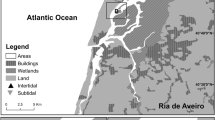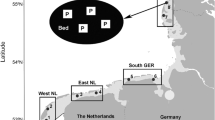Abstract
Spatial heterogeneities in the abundance of free-living organisms as well as in infection levels of their parasites are a common phenomenon, but knowledge on parasitism in invertebrate intermediate hosts in this respect is scarce. We investigated the spatial pattern of four dominant trematode species which utilize a common intertidal bivalve, the cockle Cerastoderma edule, as second intermediate host in their life cycles. Sampling of cockles from the same cohort at 15 sites in the northern Wadden Sea (North Sea) over a distance of 50 km revealed a conspicuous spatial heterogeneity in infection levels in all four species over the total sample as well as among and within sampling sites. Whereas multiple regression analyses indicated the density of first intermediate upstream hosts to be the strongest determinant of infection levels in cockles, the situation within sites was more complex with no single strong predictor variable. However, host size was positively and host density negatively correlated with infection levels and there was an indication of differential susceptibility of cockle hosts. Small-scale differences in physical properties of the habitat in the form of residual water at low tide resulted in increased infection levels of cockles which we experimentally transferred into pools. A complex interplay of these factors may be responsible for within-site heterogeneities. At larger spatial scales, these factors may be overridden by the strong effect of upstream hosts. In contrast to first intermediate trematode hosts, there was no indication for inter-specific interactions. In other terms, the recruitment of trematodes in second intermediate hosts seems to be largely controlled by pre-settlement processes both among and within host populations.





Similar content being viewed by others
References
Andrewartha HG, Birch LC (1954) The distribution and abundance of animals. University of Chicago Press, Chicago, Ill.
Begon M, Harper JL, Townshend CR (1996) Ecology. Individuals, populations and communities. Blackwell Science, Oxford
Boulinier T, Ives AR, Danchin E (1996) Measuring aggregation of parasites at different host population levels. Parasitology 112:581–587
Combes C (2001) Parasitism. The ecology and evolution of intimate interactions. University of Chicago Press, Chicago, Ill.
Connell JH (1983) On the prevalence and relative importance of interspecific competition: evidence from field experiments. Am Nat 122:661–696
Esch GE, Curtis LA, Barger MA (2001) A perspective on the ecology of trematode communities in snails. Parasitology 123:S57–S75
Fernandez J, Esch GW (1991) Guild structure of larval trematodes in the snail Helisoma anceps: patterns and processes at the individual level. J Parasitol 77:528–539
Fredensborg BL, Mouritsen KN, Poulin R (2006) Relating bird host distribution and spatial heterogeneity in trematode infections in an intertidal snail—from small to large scale. Mar Biol 149:275–283
Gätje C, Reise K (1998) Ökosystem Wattenmeer, Austausch-, Transport- und Stoffumwandlungsprozesse. Springer, Berlin Heidelberg New York
Grosholz ED (1994) The effects of host genotype and spatial distribution on trematode parasitism in a bivalve population. Evolution 48: 1514–1524
Hechinger RF, Lafferty KD (2005) Host diversity begets parasite diversity: bird final hosts and trematodes in snail intermediate hosts. Proc Biol Sci 272:1059–1066
Kareiva P, Tilman D (eds) (1998) Spatial ecology: the role of space in population dynamics and interspecific interactions. Princeton University Press, Princeton, N.J.
Kuris AM (1990) Guild structure of larval trematodes in molluscan hosts: prevalence, dominance, and significance of competition. In: Esch GW, Bush AO, Aho JM (eds) Parasite communities: patterns and processes. Chapman & Hall, London, pp 69–100
Kuris AM, Lafferty KD (1994) Community structure: larval trematodes in snail hosts. Annu Rev Ecol Syst 25:189–217
Lackschewitz D, Menn I, Reise K (2002) Das marine Ökosystem um Sylt unter veränderten Klimabedingungen. In: Daschkeit H, Schottes P (eds) Klimafolgen für Mensch und Küste am Beispiel der Nordseeinsel Sylt. Springer, Berlin Heidelberg New York, pp 153–180
Lauckner G (1971) Zur Trematodenfauna der Herzmuscheln Cardium edule und Cardium lamarcki. Helgol Wiss Meeresunt 22:377–400
Lauckner G (1980) Diseases of Mollusca: Gastropoda. In: Kinne O (ed) Diseases of marine animals, vol I. General aspects, Protozoa to gastropoda. Wiley, New York, pp 311–424
Lauckner G (1983) Diseases of Molusca: Bivalvia. In: Kinne O (eds) Diseases of marine animals, vol 2 .Introduction, Bivalvia to Scaphopoda. Biologische Anstalt Helgoland, Hamburg, pp 477–961
Lepitzki DAW, Scott ME, McLaughlin JD (1994) Influence of storage and examination methods on the recovery and size of metacercariae of Cyathocotyle bushiensis and Sphaeridiotrema pseudoglobulus (Digenea). J Parasitol 80:454–460
Loos-Frank B (1967) Experimentelle Untersuchungen über Bau, Entwicklung und Systematik der Himastlinae (Trematoda, Echinostomatidae) des Nordseeraumes. Z Parasitenkd 28:299–351
Montaudouin X de, Kisielewski I, Bachelet G, Desclaux C (2000) A census of macroparasites in an intertidal bivalve community, Arcachon Bay, France. Oceanol Acta 23:453-468
Mouritsen KN, McKechnie S, Meenken E, Toynbee JL, Poulin R (2003) Spatial heterogeneity in parasite loads in the New Zealand cockle: the importance of host condition and density. J Mar Biol Assoc UK 83:307–310
Ostfeld RS, Glass GE, Keesing F (2005) Spatial epidemiology: an emerging (or re-emerging) discipline. Trends Ecol Evol 20:328–336
Paine RT (1966) Food web complexity and species diversity. Am Nat 100:65–75
Pietrock M, Marcogliese DJ (2003) Free-living endohelminth stages: at the mercy of environmental conditions. Trends Parasitol 19:293–299
Poulin R (2006) Global warming and temperature-mediated increases in cercarial emergence in trematode species. Parasitology 132:134–151
Poulin R, Mouritsen KN (2004) Small-scale spatial variation in rates of metacercarial accumulation by a bivalve second intermediate host. J Mar Biol Assoc UK 84:1209–1212
Poulin R, Rate SR (2001) Small-scale heterogeneity in infection levels by symbionts of the amphipod Talorchesta quoyana (Talitridae). Mar Ecol Prog Ser 212:211–216
Poulin R, Steeper MJ, Miller AA (2000) Non-random patterns of host use by the different parasite species exploiting a cockle population. Parasitology 121:289–295
Quinn GP, Keough MJ (2002) Experimental design and data analysis for biologists. Cambridge University Press, Cambridge
Rantanen J, Valtonen E, Holopainen I (1998) Digenean parasites of the bivalve mollusc Pisidium amnicum in a small river in eastern Finland. Dis Aquat Org 33:201–208
Rohde K (1979) A critical evaluation of intrinsic and extrinsic factors responsible for niche restriction in parasites. Am Nat 114:648–671
Rohde K (1994) Niche restriction in parasites: proximate and ultimate causes. Parasitology 109:69–84
Shaw DJ, Dobson AP (1995) Patterns of macroparasite abundance and aggregation in wildlife populations: a quantitative review. Parasitology 111:S111–S133
Sousa WP (1990) Spatial scale and the processes structuring a guild of larval trematode parasites. In: Esch GW, Bush AO. Aho JM (eds) Parasite communities: patterns and processes. Chapman & Hall, London, pp 41–67
Thieltges DW, Reise K (2006a) Metazoan parasites in intertidal cockles (Cerastoderma edule) from the northern Wadden Sea. J Sea Res (in press)
Thieltges DW, Rick J (2006b) Effect of temperature on emergence, survival and infectivity of cercariae of the marine trematode Renicola roscovita (Digenea: Renicolidae). Dis Aquat Organ (in press)
Thomas F, Poulin R (1998) Manipulation of a mollusc by a trophically transmitted parasite: convergent evolution ot phylogenetic inheritance? Parasitology 116:431–436
Thomas F, Mete K, Helluy S, Santalla F, Verneau O, Meeus T de, Cezilly F, Renaud F (1997) Hitch-hiker parasites or how to benefit from the strategy of another parasite. Evolution 51:1316–1318
Thomas F, Renaud F, Poulin R (1998) Exploitation of manipulators: “hitch-hiking" as a parasite transmission strategy. Anim Behav 56:199–206
Wegeberg AM, Jensen KT (2003) In situ growth of juvenile cockles, Cerastoderma edule, experimentally infected with larval trematodes (Himasthla interrupta). J Sea Res 50:37– 43
Wegeberg AM, Montaudouin X de, Jensen KT (1999) Effect of intermediate host size (Cerastoderma edule) on infectivity of cercariae of three Himasthla species (Echinostomatidae, Trematoda). J Exp Mar Biol Ecol 238:259–269
Werding B (1969) Morphologie, Entwicklung und Ökologie digener Trematoden-Larven der Strandschnecke Littorina littorea. Mar Biol 3:306–333
Wetzel EJ, Shreve EW (2003) The influence of habitat on the distribution and abundance of Marovestibulum obtusicaudum (Pronocephalidae) in a small Indina stream. J Parasitol 89:1088–1090
Wiens JA (1989) Spatial scaling in ecology. Funct Ecol 3:385–397
Wilson K, Bjornstad ON, Dobson AP, Merler S, Poglayen G, Randolph SE, Read AF, Skorping A (2002) Heterogeneities in macroparasite infections: patterns and processes. In: Hudson PJ, Rizzoli A, Grenfell BT, Heesterbeek, Dobson AP (eds) The ecology of wildlife diseases. Oxford Univeristy Press, Oxford, pp 6–44
Acknowledgements
We wish to thank Jan Fermer, Kristin Finger, Doreen Kazmierczak, Sylvia Pross and Katrin Prinz for their help in the field and laboratory. Dörte Poszig is thanked for assisting in a laborious field campaign. Werner Armonies and three anonymous referees considerably helped to improve our manuscript.
Author information
Authors and Affiliations
Corresponding author
Additional information
Communicated by Martin Attrill.
Rights and permissions
About this article
Cite this article
Thieltges, D.W., Reise, K. Spatial heterogeneity in parasite infections at different spatial scales in an intertidal bivalve. Oecologia 150, 569–581 (2007). https://doi.org/10.1007/s00442-006-0557-2
Received:
Accepted:
Published:
Issue Date:
DOI: https://doi.org/10.1007/s00442-006-0557-2




